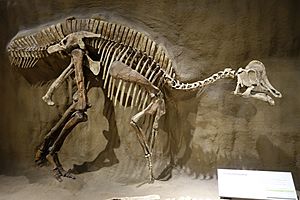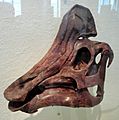Hypacrosaurus facts for kids
Quick facts for kids HypacrosaurusTemporal range: Upper Cretaceous 75–67 mya
|
|
|---|---|
 |
|
| Reconstructed skeleton | |
| Scientific classification | |
| Kingdom: | |
| Superclass: | |
| Class: | |
| Superorder: | |
| Order: | |
| Family: | |
| Genus: |
Hypacrosaurus
Brown, 1913
|
Hypacrosaurus (say "Hy-pak-roh-SAWR-us") means "almost the largest lizard." This amazing dinosaur was a huge plant-eater with a special hollow crest on its head, much like its cousin, Corythosaurus. It was a type of duck-billed dinosaur, known for its wide, flat beak.
Hypacrosaurus grew to be about 30 feet (9 meters) long, which is roughly the length of a school bus! It had nearly 40 rows of cheek teeth for grinding plants, but its beak at the front was toothless. A row of long spines along its back bones (vertebrae) formed a tall fin, making it look even bigger. Scientists believe these dinosaurs lived between 75 and 67 million years ago.
Where it Lived
Fossils of Hypacrosaurus have been found in two main places: Alberta, Canada, and Montana, United States. These areas were part of North America during the Upper Cretaceous period. Hypacrosaurus is one of the last known hollow-crested duck-billed dinosaurs from North America for which we have good fossil evidence.
Family Life and Reproduction
For a long time, Hypacrosaurus was not very well known. But in the 1990s, scientists made an exciting discovery! They found nests, eggs, and even baby Hypacrosaurus fossils. These finds belonged to one of the Hypacrosaurus species, Hypacrosaurus stebingeri.
Finding nests and young dinosaurs helps us learn a lot about how these ancient creatures lived and raised their families. It showed that Hypacrosaurus likely laid eggs in nests, and perhaps even cared for its young, much like some modern birds do. These discoveries made Hypacrosaurus a much more famous and important dinosaur in the world of paleontology.
Images for kids
-
H. altispinus skull, AMNH
-
Hypacrosaurus MOR 548 supraoccipital with microscopic magnification showing the preserved chondrocyte-like structures, in comparison to those of an emu
See also
 In Spanish: Hypacrosaurus para niños
In Spanish: Hypacrosaurus para niños







